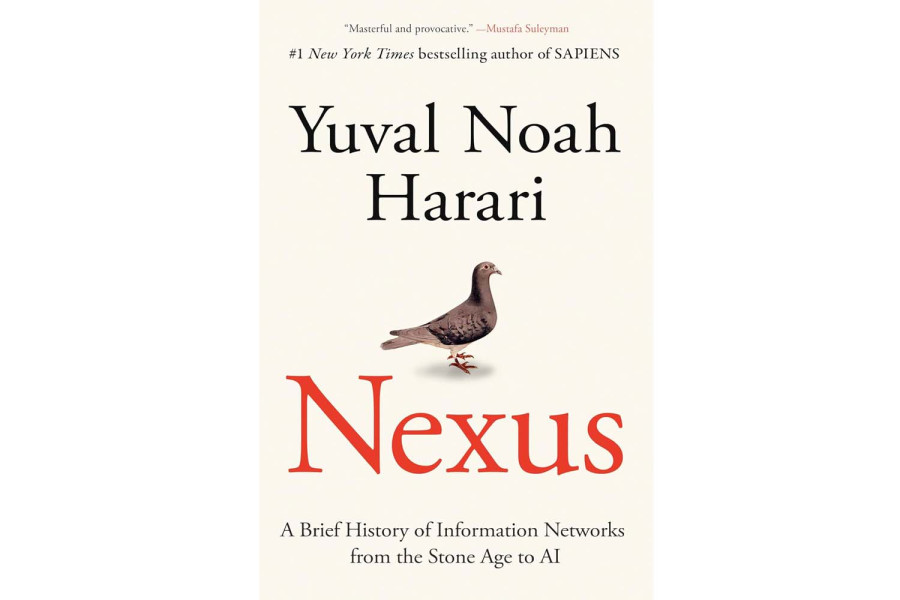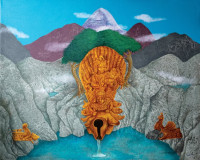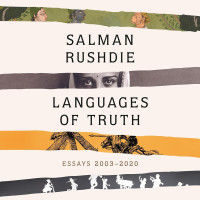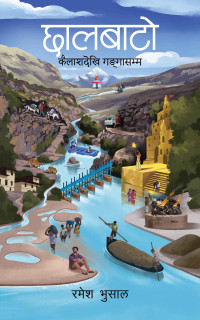Books
‘Nexus’: Navigating the information maze
From religious texts to AI-generated content, Yuval Noah Harari tracks how powerful people have controlled information to influence belief, behaviour, and the future.
Narayan Prasad Ghimire
The only constant is change, especially in the way people think. This mindset shift is greeted with many opportunities and challenges. Information lies at the very centre of this development.
Information propels society ahead, for good or bad. As media undergoes rapid transformations, particularly driven by technology, how information is produced and consumed has changed significantly.
While it brings woes to many and euphoria to a select few, artificial intelligence (AI) has emerged as an unprecedented technology, upending numerous businesses and pushing human skills and creativity to the edge.
Scientists mobilised by tech behemoths are advancing forceful and fierce competition, which one of the acclaimed writers of our time, Yuval Noah Harari, refers to as the ‘dog-eat-dog’ age. In his latest, ‘Nexus: A Brief History of Information Networks from the Stone Age to AI,’ Harari reveals how the stages of information impacted different regimes, built narratives, and fueled conspiracies.
At a time when a significant section still focuses on the positive aspects of the adage—‘information is power’, ‘Nexus’ presents various examples of information curated, cocooned, manipulated, and weaponised by those in power.
Information empowers individuals and systems in various ways. Traditional institutions like churches, libraries, and schools, along with radio broadcasts, online content, and AI-generated information, establish a context in which various individuals can exercise power.
According to the writer, churches were mighty institutions in the late modern era when modern information technology became available. At the same time, he wrote, “With the advent of radio, the pope became one of the most powerful people on the planet.”
Harari compares how information is passed or dealt with in different systems—democratic and totalitarian. “Totalitarianism wants all information to pass through the central hub and does not want any independent institutions making decisions on their own.”
Although comparing information flow—control in totalitarian systems and eased and decentralised in democratic systems, the writer argues that a controlled and centralised flow of information is sometimes beneficial, especially in cases of emergencies like wars and epidemics, reasoning that it moves quicker and farther than distributed networks.
Regarding the role of information in spurring debate or spreading conspiracy, Harari underscores the importance of a ‘curation institution’ to foster free, fair, and factual information and debate on pressing issues. Curation institutions play a vital role in creating and dominating the narrative that advances society, for they advocate for scientific truth rather than baseless information and whims.
As he argues, the curation institutions are not the universities but free institutions that link universities and researchers. Such institutions help interpret the information regime and contribute to a healthy information ecosystem.
Various historical references on how the curation institutions played their parts in laying the foundation of the scientific revolution are provided. The writer advocates for a regulated flow of information rather than always agreeing to an entirely free information market. Arguing that AI is worse than the previous achievement, nuclear advent, Harari suggests taming it with utmost care and collaboration.
Moreover, his allusion to the human body as a self-correcting mechanism persuades the readers. Different chemicals have different functions, but they complement each other to keep the body healthy and functional. He terms this process a ‘self-correcting mechanism’ and argues that a system needs a similar mechanism. In his argument, a robust self-correcting mechanism admits the mistakes and moves forward accordingly. In the present system, where information is fueled by non-organic elements, such as AI, the self-correcting mechanisms must be strong so that the democratic system will not be dented and blunted.
The book brings to light rich historical references on how wrong elements and false information took toll on correct elements, true information, and scientific texts.
A careful reading of history shows how the printing press once overwhelmed the information sphere, primarily through books like ‘The Hammer of the Witches’, which fed on people’s deepest fears, spreading fantasy and falsehood. The witch hunts in early modern Europe and the devastation they caused are effectively illustrated through this example. It highlights how an early information network was built around emotionally charged content. Over time, however, this was dismantled by institutions focused on curation and verification, paving the way for Europe’s transition to modernism and scientific discovery. He notes, “The scientific revolution was launched by the discovery of ignorance.”
Harari’s book—like ‘21 Lessons for the 21st Century’—not only stirs anxiety about the future and our readiness to face it, but also serves as a wake-up call. The fear it evokes can inspire farsighted leaders and advocates to work toward a more livable and just world. This book is a valuable resource for anyone exploring the history of information—how it is shaped, framed, and used to drive narratives. As the title suggests, information is not just a message, but a product of interconnection and a tool of influence. It offers ample insights to understand information beyond the narrow lens of communication.
In addition to the prologue and epilogue, the book is divided into three parts: ‘Human Networks’, ‘The Inorganic Network’, and ‘Computer Politics’. Harari describes today’s IT advancements—such as the internet, digital innovation, algorithms, machine learning, and artificial intelligence—as byproducts of the computer age. The spread, curation, control, and influence of information today is perhaps best summed up in his striking line: “Silicon chips can create spies that never sleep, financiers that never forget, and despots that never die.” This powerful sentence points to the future of power and influence in a digital world.
Harari connects this modern information landscape to a long journey—from faith, religion, and fabrication through rejection and recovery. He describes this shift as a move from intersubjective reality to inter-computer reality. He warns that with modern modes of information flow, humanity now faces a ‘radically alien and fallible computer network.’
As the inter-computer reality increasingly handles the information regime, the writer argues it is time to tame algorithms and prod all stakeholders to create ‘living institutions’ to tackle the threats wisely and humanely. The writer, however, does not argue that technology is bad either. To substantiate, the writer argues, “Novel technology often leads to historical disasters, not because technology is inherently bad, but because it takes time for humans to learn how to use it wisely.”




 8.12°C Kathmandu
8.12°C Kathmandu










